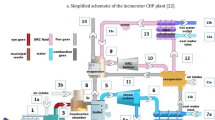Abstract
In order to comprehensively assess the resource utilization of a process system and its influence on the environment, the application range of the traditional exergy analysis was expanded in this paper to include the pollution degree of the discharged wastes to the environment. So technology indexes can be obtained to comprehensively assess the resource utilization and the environment impact of a process system. The harm coefficient and effect coefficient were introduced to concern the different harm to the environment of the different wastes and the pollution effect relative to resource waste by environment. The determination method of the harm coefficient and effect coefficient was discussed. Two suspension polymerization flows of polyvinyl chloride were calculated with this method. The results show that the method can comprehensively assess the resource utilization and the environment impact of the chemical process system by comparing and analyzing.
Similar content being viewed by others
References
Xu Songling, Measurement of Economic Loss of Environment Damage in China—Example and Theory, Beijing: Environment Science Press of China, 1998, 7–9.
Douglas, J. M., Process synthesis for waste minimization, Ind. Eng. Chem. Res., 1992, 31(1): 238.
Flower, J. R., Bikos, S. C., Johnson, S. W., The graphical mass balance in the early design of clean processes, Tran. of IChE, Part B, 1993, 194.
Ei-Hakwagi, M. M., Manousiouthakis, V., Synthesis of mass exchange networks, AIChE Jl., 1989, 35(8): 1233.
Wang, Y. P., Smith, R., Wastewater minimization, Chem. Eng. Sci., 1994, 49(7): 881.
Pistikopoulos, E. N., Stefanis, S. K., Livingston, A. G., A methodology for minimum environmental impact analysis, AL-CHE Symposium Series, Volume on Pollution Prevention through Process and Product Modifications, 1994, 90(303): 139.
Stefanis, S. K., Livingston, A. G., Pistikopoulos, E. N., Minimizing the environmental impact of process plants: A process systems methodology, Computers and Chemical Engineering, 1996, 20: S 1419.
Rivero, R., The Exergoecologic improvement potential of industrial processes, in Proc.of TAIES’97, Beijing: World Publishing Corporation, 1997, 299–304.
Stefanis, S. K., Buxton, A., Livingston, A. G. et al., A methodology for environmental impact minimization: Solvent design and reaction path synthesis issues, Computers and Chemical Engineering, 1997, 21: S 1419.
Rosen, M. A., Dincer, I., On exergy and environmental impact, International Journal of Energy Research, 1997, 21: 643.
Wang Yanfeng, Feng Xiao, Exergy analysis involving resource utilization and environmental influence, Computers and Chemical Engineering, 2000, 24: 1243.
Wang Jing?He Deke?Wang Yaoqu, The Handbook of Assessment Environment Data—Toxic Substance Identification Data, Beijing: Chemical Industry Press, 1988, 424–426.
Xiang Xinyao, Exergy Analysis Method in Engineering (in Chinese), Beijing: Petroleum Industry Press?1990, 313–314.
The Laws Assembly of Pollute Penalty (1982 –1996), Xi’an: Environment Supervision and Control Office in Xi’an City, 1997, 199–208.
Sahaku, Y., Closed System of Chemical Production (in Chinese), (translated by Yu Puyi, An Jiaju, Liu Renkan), Beijing: Chemical Industry Press, 1987, 43–58.
Author information
Authors and Affiliations
Corresponding author
Rights and permissions
About this article
Cite this article
Wang, Y., Feng, X. Analysis of the suspension polymerization flows of polyvinyl chloride with the exergy analysis involving resource utilization and environmental influence. Sc. China Ser. B-Chem. 44, 93–102 (2001). https://doi.org/10.1007/BF02879741
Received:
Issue Date:
DOI: https://doi.org/10.1007/BF02879741




